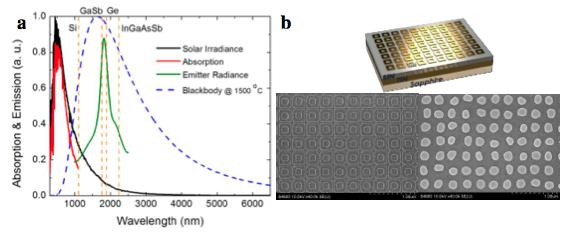Nanophotonics at CLEO:2014
Howard Lee
Titanium Nitride (TiN) as a new material for thermophotovotaics
To enhance the efficiency of thermo-photovoltaics, the amount of unusable photons that are lost (with energy photon lower than the bandgap of the photovoltaics) needs to be minimized, while the operational temperatures needs to be kept high (~1500°C) to enhance the power output, thus the emitter needed to convert the input thermal energy into the emission above the band-gap of photovoltaic cells. Dr. Urcan Guler and Jingjing Liu (FM4C.5, FM4C.8) (from the groups of Alexandra Boltasseva and Vladimir Shalaev at Purdue university) presented the use of TiN material to make a ultra-thin plasmonic thermal emitter. Their selective emitter shows high emittance around 2.5 μm and shorter wavelengths, and suppresses emittance at longer wavelengths (while working at high temperature of 830K) (figure below). As discussed by Guler, such high melting temperature TiN (melting temperature of 2950 degree celsius) together with metallic properties and high absorption is potentially useful for the field of thermo-photovoltaic applications and heat-assisted magnetic recording (HAMR), where high temperature environment are required.

Fig. 1. (a) Absorption of TiN metamaterial absorber and radiance of TiN selective emitter given along with solar irradiance and emission from a blackbody at 1500 oC. Dashed orange lines show the bandgap energies of several thermophotovoltaic semiconductors. (b) Metamaterial broadband absorber design (top) given with SEM images of TiN (left) and Au (right) samples after thermal testing at 800 oC for 1 hour. [FM4C.5, FM4C.8]
